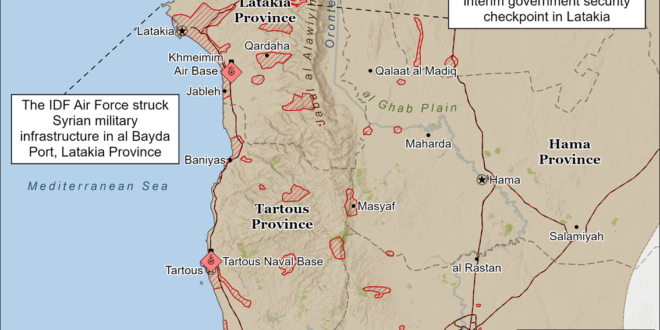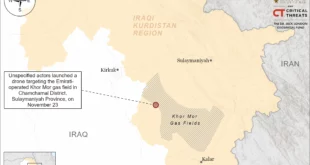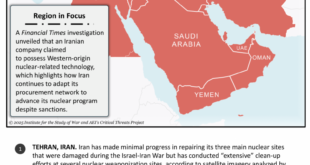Iran responded on March 26 to US President Donald Trump’s letter proposing nuclear negotiations.[i] Iran signaled it is open to indirect nuclear negotiations with the United States but rejects direct negotiations under the current conditions. Trump sent a letter to Khamenei on March 5 that proposed negotiations on Iran’s nuclear program, and Iran responded to the letter via Oman on March 26.[ii] Iranian Foreign Affairs Minister Abbas Araghchi said that Iran is open to indirect talks with the United States, though it rejects direct negotiations under the current US “maximum pressure” campaign and US-Israeli threat of military action against Iran’s nuclear program. US Director of National Intelligence Tulsi Gabbard stated on March 25 that Trump’s letter to Iran proposed “direct talks” and emphasized that “there would be military consequences if there were no direct negotiations.”[iii] It is unclear if Iran’s openness to indirect negotiations will fulfill US conditions to grant sanctions relief or avoid military action against Iran’s nuclear program.
This likely suggests that Iranian Supreme Leader Ali Khamenei has approved indirect negotiations with the United States. Araghchi said that Iran conducted such indirect talks under former presidents Hassan Rouhani and Ebrahim Raisi. Senior Iranian officials, including Supreme Leader Adviser Kamal Kharazi, have also recently expressed willingness to engage in indirect negotiations with the United States.[iv] That Kharazi spoke to state media may suggest that Iranian officials are concerned about internal unrest over Iran’s economic situation and want to signal to the Iranian population that the regime is willing to take steps to secure economic relief.[v]
The Islamic Resistance Front in Syria, which is an anti-Israel militia, claimed that it is an independent Syrian militia. It is abnormal that an independent militia would use iconography widely associated with Iranian-backed actors (see graphic below). A media official from the Islamic Resistance Front in Syria told Lebanese media on March 27 that the group does not receive “internal or external” support from Iran or Iranian-backed actors in the region.[vi] The official described the group as an “integrated organization” with political, social, military, and legal offices.[vii] There is no evidence that the group has any affiliations with external actors, but it is unclear why an independent local actor would decide to use iconography that many Syrians and people in the region and the world widely associate with Iran and its proxies and partners.[viii] The group initially established itself on January 8 as the ”Southern Liberation Front” and used red, green, and black text over a grey map of Syria as its logo until January 12, when it changed to the current logo.[ix]
The Islamic Resistance Front in Syria said it communicated with the Coastal Shield Brigades, a sectarian Alawite insurgent group in western Syria, but broke off communications after the Coastal Shield Brigades launched its military offensive in early March.[x] The media official said that the Islamic Resistance Front in Syria opposed the killing of any Syrians, indicating that the group is attempting to present itself as cross-sectarian. The official also referred to the current government as an ”internal enemy,” suggesting that the Islamic Resistance Front in Syria is opposed to the current government and may hold Assadist views.[xi] The official said that the Islamic Resistance Front in Syria cannot conduct many operations due to the interim government’s ”movements.” Fourteen members of the group have been killed in operations against the Israelis, however.[xii]

Key Takeaways:
Iranian Nuclear Negotiations: Iran responded on March 26 to US President Donald Trump’s letter proposing nuclear negotiations. Iran signaled it is open to indirect nuclear negotiations with the United States but rejects direct negotiations under the current conditions. Iranian Supreme Leader Ali Khamenei has likely approved indirect negotiations with the United States but rejected direct negotiations.
Anti-Government Militias in Syria: The Islamic Resistance Front in Syria, which is an anti-Israel militia, claimed that it is an independent Syrian militia. It is abnormal that an independent militia would use iconography widely associated with Iranian-backed actors. This group also referred to the interim government as an “internal enemy” and communicated with other anti-government insurgents in western Syria before early March.
Syria
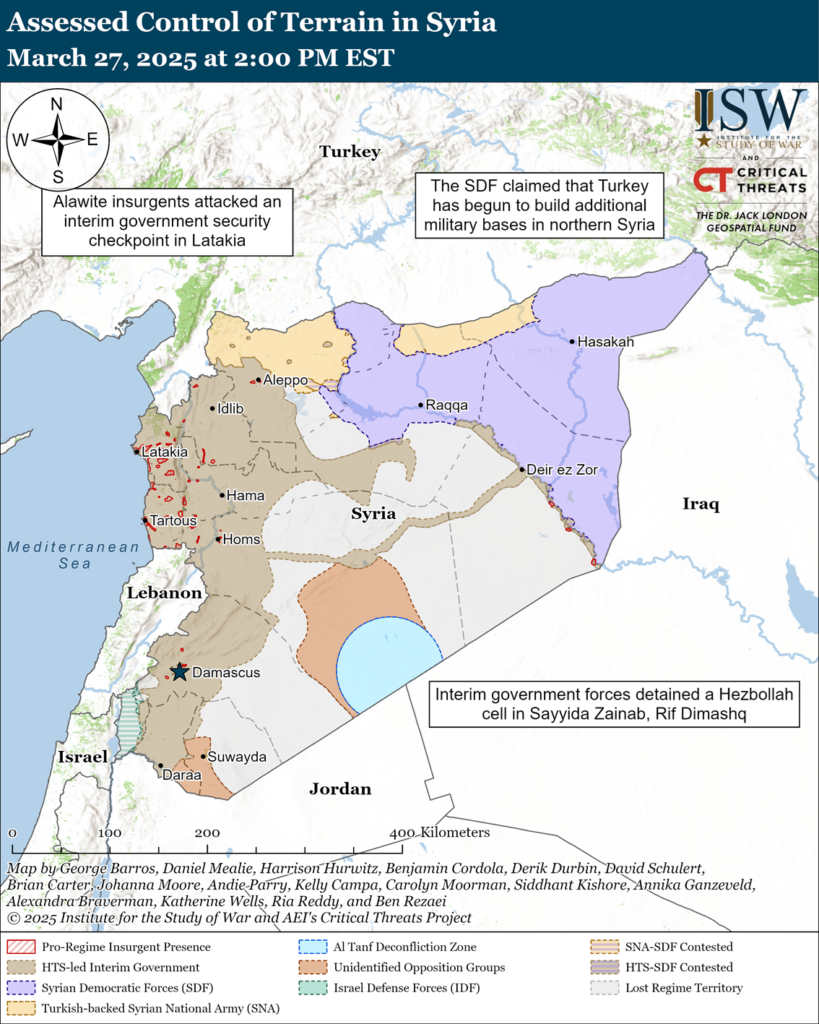
Two Syrian journalists reported that Syrian Interim President Ahmed al Shara is expected to appoint some Syrian minorities as ministers in his transitional government in the coming days. Syrian journalist Ibrahim Hamidi reported on March 26 that Shara’s appointments will include members of Syria’s Arab, Kurdish, Sunni, Alawite, Christian, and Druze communities.[xiii] Another Syrian journalist reported that Shara has appointed Hind Qabawat as Minister of Social Affairs.[xiv] Qabawat is a Christian who has spent years promoting interfaith tolerance, women’s rights, and conflict resolution in Syria.[xv] The journalist reported that the Minister of Economy and Foreign Trade will be Nidal al Shaar, who formerly served in the position under Assad until 2012.[xvi] Syrian White Helmets head Raed al Saleh will reportedly lead a department dedicated to emergency response and reconstruction.[xvii] Shara is expected to announce all 22 ministers before March 30.[xviii] Shara’s appointments will be a strong indicator of the sort of government and state Shara intends to lead.
A Damascus-based outlet reported on March 27 that Shara will also soon announce the members of a fatwa council.[xix] Syrian outlet Voice of the Capital reported that Shara will announce his five appointments to the council when he announces the other ministerial appointments.[xx] The Syrian constitutional declaration does not define the fatwa council‘s role within the state, though it establishes that the country’s laws will be based on Islamic jurisprudence.[xxi] Shara’s rumored appointees include several notable HTS-affiliated scholars, including Sheikh Abdul Rahim Atun and Mazhar al Wais.[xxii] Both Atun and Wais have been affiliated with Shara and HTS since at least 2017.[xxiii] Voice of the Capital also reported that Shara will appoint National Preparatory Committee spokesperson Hassan al Daghim, who previously led the Turkish-backed Syrian National Army’s (SNA) Moral Guidance Department and recently swore allegiance to Shara at the January 29 Victory Conference.[xxiv] Sheikh Osama al Rifai is also expected to join the council.[xxv] The Syrian Islamic Council, which was a body of Sunni Islamic scholars that opposed the Assad regime, appointed Rifai as the Grand Mufti in Syria in 2021 after the regime abolished the office.[xxvi] Rifai has connections to Turkish President Recep Tayyip Erdogan and the Muslim Brotherhood.[xxvii] HTS established a High Council of Fatwa in Idlib in 2019 that Shara effectively controlled and used to sideline his hardline Islamist rivals.[xxviii] Shara’s ability to use the council against his rivals will remain unclear until he officially announces the council’s members.
The Israel Defense Forces (IDF) Air Force reportedly struck Syrian military infrastructure in Latakia Province on March 26.[xxix] The IDF reportedly conducted six consecutive airstrikes targeting military sites, including weapon depots, in the al Bayda Port.[xxx] Syrian media reported that the IDF also struck the 110th Naval Brigade in Ras Shamra, northern Latakia Province.[xxxi] The IDF previously struck al Bayda Port on December 10 and 11 and destroyed Syrian naval vessels and anti-ship missiles.[xxxii] The IDF has not commented on these airstrikes at this time of writing.
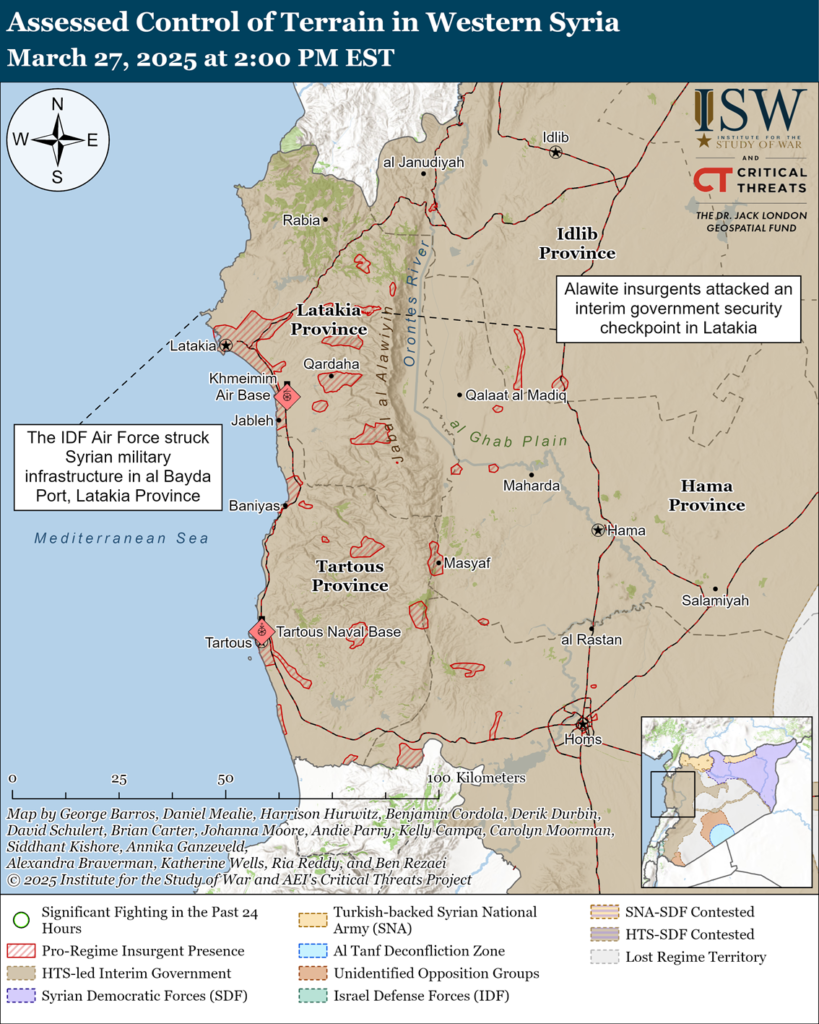
The Syrian government is probably engaging China to secure Chinese support for the transition. Syrian Interim Foreign Minister Asaad al Shaibani discussed bilateral relations with a Chinese delegation led by the Chinese Ambassador to Syria Shi Hongwei in Damascus on March 26.[xxxiii] The delegation reaffirmed China’s support for Syria’s sovereignty, territorial integrity, and independence during the meeting. Shaibani expressed his interest in enhancing cooperation with China.[xxxiv] This is the second official visit by a Chinese delegation to Syria since the fall of the Assad regime.[xxxv]
Turkey and the Turkish-backed Syrian National Army (SNA) did not engage the Syrian Democratic Forces (SDF) on March 27.
The SDF claimed that Turkey began to build additional military bases in northern Syria on March 27.[xxxvi] The SDF said that Turkey has transported military equipment and building supplies to construct watchtowers, tank and artillery fortifications, and headquarters in areas of Syria held by the SNA.[xxxvii] The SDF said that the bases are near southeast of Manbij and near Qara Qozak along the Euphrates River.[xxxviii] CTP-ISW has not yet observed any construction in these areas. A Turkish Defense Ministry spokesperson said that Turkey may establish a military base in Syria to assist the Syrian government.[xxxix] This likely refers to a base for training and capacity-building rather than a firebase designed to support SNA operations against the SDF.
The interim Interior Ministry detained several Lebanese Hezbollah cell members in Sayyida Zainab, Rif Dimashq Province, on March 27.[xl] The Interior Ministry said that the Hezbollah cells planned to conduct “criminal operations” in the area.[xli] It is unclear if “criminal operations” refers to drug trade or insurgent anti-Damascus activity. Iranian-backed militias and the Islamic Revolutionary Guards Corps controlled the Sayyida Zainab Shrine area during the Assad regime, making it unsurprising that some Hezbollah personnel remain in the area. The interim government took control of the Sayyida Zainab Shrine in December 2024.[xlii]
Likely Alawite insurgents attacked an interim government security checkpoint near Salnafah, Latakia Province, on March 26.[xliii] Alawite insurgents previously attacked a security forces checkpoint near Salnafah on March 9.[xliv]
Syrian security forces seized a large quantity of weapons and combat equipment from pro-Assad insurgents in old Damascus City on March 26.[xlv] The seized weapons and equipment included rockets, explosives, night vision equipment, communication devices, and ammunition.[xlvi] Security forces also arrested several individuals affiliated with the Assad regime during the operation.[xlvii] Security forces have consistently conducted operations against Assadist insurgents in Damascus and its surrounding areas since January 2025.[xlviii]
Iraq
Axis of Resistance Objectives:
Strengthen Iranian and Axis of Resistance influence over the Iraqi state and society
Harden the Iraqi government against internal dissent
The Iraqi Parliamentary Security and Defense Committee, which is led by a member of the Iranian-backed Badr Organization, called for removing the Popular Mobilization Authority Law from the parliamentary agenda.[xlix] The Popular Mobilization Authority Law differs from the Popular Mobilization Forces (PMF) Service and Retirement Law, which Iraqi Prime Minister Mohammad Shia al Sudani withdrew from the parliamentary agenda on March 12.[l] The PMF Service and Retirement Law requires Popular Mobilization Committee (PMC) Chairman Faleh al Fayyadh to retire, while the Popular Mobilization Authority Law allows Fayyadh to continue serving as PMC chairman for “an indefinite period” and grants Fayyadh a ministerial rank.[li] Promoting Fayyadh to a ministerial position would put him on par with other senior Iraqi security officials who hold a ministerial rank, such as the defense minister.
The Popular Mobilization Authority Law also reportedly stipulates that unspecified senior PMF officials will receive deputy minister posts in the Iraqi federal government.[lii] The PMF includes many Iranian-backed Iraqi militias. The appointment of PMF officials to senior government posts could, therefore, further increase Iranian influence in the Iraqi federal government. The Popular Mobilization Authority Law designates the PMF as a “parallel military force” alongside the Iraqi Army and allows Iraqi Army officers to be appointed to senior and mid-ranking positions in the PMF. Sudani and future prime ministers could use this provision to rein in the Iranian-backed Iraqi militias in the PMF by appointing individuals not affiliated with or loyal to the militias to senior PMF positions. It is unclear if senior PMF officers could also be appointed as commanders in the Iraqi Army.
An Iraqi militia formed in January 2025, Kataib Awliya al Haq, threatened to strike US “allies, bases, and embassies” if the US struck Iraq.[liii] Iraqi Foreign Minister Faud Hussein acknowledged in an interview on March 22 that a failure to reach an agreement with Iranian-backed Iraqi militias, purportedly to avoid striking Israel or US forces in Iraq and Syria, could lead to US or Israeli strikes in Iraq.[liv] A Shia politician told Iraqi media on March 19 that the militias may resume unspecified activities due to regional developments, likely in reference to Israeli operations in the Gaza Strip or US airstrikes targeting the Houthis.[lv] Kataib Awliya al Haq claims to be a part of the “Islamic Resistance,” which is a term typically used by Iranian-backed Iraqi militias.[lvi] The group’s logo closely resembles other Iranian-backed Iraqi militias, including Saraya Awliya al Dam.[lvii]
Kataib Awliya al Haq announced on January 22 that it would begin unspecified military activities in Iraq and threatened to respond “harshly” to US actions against its fighters.[lviii] Kataib Awliya al Haq said on January 25 that it would begin military operations and enter Syria to protect Alawites “as soon as possible.”[lix] Multiple Iraqi groups have recently formed in response to sectarian violence in Syria.[lx] It is not clear if these groups are connected to Iranian-backed Iraqi militias.
Arabian Peninsula
Axis of Resistance objectives:
Harden the Houthi regime against internal dissent in Houthi-controlled areas
Destroy the anti-Houthi opposition in order to control all of Yemen
Erode Israeli will to continue the war in the Gaza Strip
US Central Command (CENTCOM) has conducted at least 23 airstrikes targeting Houthi infrastructure and leadership in Houthi-controlled areas of Yemen since CTP-ISW’s last data cutoff on March 26.[lxi] The Houthis conducted a combined missile and drone attack targeting the USS Harry S. Truman aircraft carrier and US destroyers in the Red Sea on March 26.[lxii] The attack did not succeed, and CENTCOM did not acknowledge the attacks.
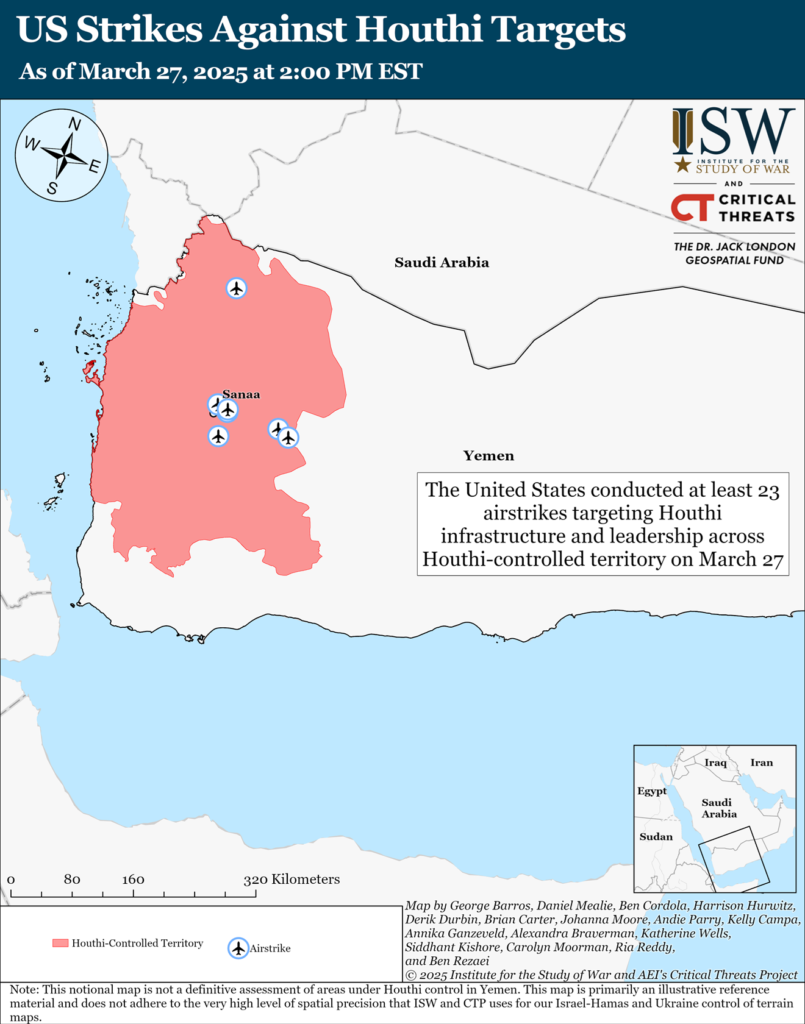
The Houthis launched two separate ballistic missile attacks at Ben Gurion Airport and at unspecified military targets in Tel Aviv on March 27.[lxiii] The Israel Defense Forces (IDF) intercepted both ballistic missiles before they entered Israeli territory.[lxiv]
The Palestinian Territories and Lebanon
Axis of Resistance objectives:
Erode the will of the Israeli political establishment and public to sustain clearing operations in the Gaza Strip
Reestablish Hamas as the governing authority in the Gaza Strip
Rebuild and reestablish Hezbollah in southern Lebanon
Establish the West Bank as a viable front against Israel
IDF strikes in southern Lebanon suggest that Hezbollah has continued to plan future attacks and rebuild military capabilities in southern Lebanon. The IDF conducted three airstrikes on March 27 that killed multiple Hezbollah fighters, including a Radwan Force battalion commander, in three separate towns in southern Lebanon.[lxv] The IDF reported that the Radwan Force battalion commander continued to plan operations against Israel after the start of the Israel-Lebanon ceasefire agreement in November 2024.[lxvi] The IDF separately reported that one strike targeted Hezbollah fighters transporting weapons approximately 5 kilometers north of the Israel-Lebanon border.[lxvii] Likely Hezbollah fighters launched rockets at northern Israel on March 22.[lxviii]
CTP-ISW will not be covering the new Israeli operation in the Gaza Strip. We have reprioritized our Middle East coverage to focus on Iran’s nuclear program, Iranian domestic security, and Iranian efforts to rebuild its networks into the Levant, including the Palestinian Territories. Given that Israel and its partners have destroyed Hamas’ military organization and severed the group’s ability to resupply itself, we are now focused on how Iran seeks to rebuild its lines of communication with Hezbollah and Hamas through Syria.
Iranian Decision-Making, Internal Dynamics, and Foreign Policy
The Iranian rial depreciated from 1,026,000 rials to one US dollar on March 26 to 1,032,000 rials to one US dollar on March 27.[lxix]
US Strategic Command reported on March 26 that Iran’s nuclear breakout time is “presumably less than one week.”[lxx] This is consistent with the Institute for Science and International Security’s assessment, citing International Atomic Energy Agency data from May 2024, that Iran’s breakout timeline for producing a nuclear weapon is about one week.[lxxi]
At least some Iranian oil tankers en route to China have slowed or stopped, likely due to US “maximum pressure” sanctions that have targeted Iranian entities and vessels involved in the trade.[lxxii] At least 11 sanctioned tankers carrying nearly 17 million barrels of oil in total now sit idle or are moving very slowly off the coast of Malaysia, according to a Bloomberg report on March 27.[lxxiii] Bloomberg also reported that the current backlog is the largest since August 2024. The slowdown highlights growing logistical challenges in Iran’s covert oil trade. The sanctions and the shipment slowdown damage the Iranian economy, which relies heavily on energy exports and revenue.
Three thousand light and heavy vessels, including Islamic Revolutionary Guards Corps (IRGC) Navy warships, Fast Attack Crafts, Basij forces, and civilian vessels, participated in the naval parade for Quds day on March 26 in the Persian Gulf and the Caspian Sea.[lxxiv] The bulk of these vessels were small craft. Quds Day is an annual Iranian-established anti-Israel celebration that occurs on the last Friday of Ramadan.[lxxv]
The Iran Update provides insights into Iranian and Iranian-sponsored activities abroad that undermine regional stability and threaten US forces and interests. It also covers events and trends that affect the stability and decision-making of the Iranian regime. The Critical Threats Project (CTP) at the American Enterprise Institute and the Institute for the Study of War (ISW) provides these updates regularly based on regional events.
CTP-ISW defines the “Axis of Resistance” as the unconventional alliance that Iran has cultivated in the Middle East since the Islamic Republic came to power in 1979. This transnational coalition is comprised of state, semi-state, and non-state actors that cooperate to secure their collective interests. Tehran considers itself to be both part of the alliance and its leader. Iran furnishes these groups with varying levels of financial, military, and political support in exchange for some degree of influence or control over their actions. Some are traditional proxies that are highly responsive to Iranian direction, while others are partners over which Iran exerts more limited influence. Members of the Axis of Resistance are united by their grand strategic objectives, which include eroding and eventually expelling American influence from the Middle East, destroying the Israeli state, or both. Pursuing these objectives and supporting the Axis of Resistance to those ends have become cornerstones of Iranian regional strategy.
 Eurasia Press & News
Eurasia Press & News
